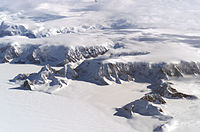
Photo from wikipedia
ABSTRACT Satellite observations of gravity anomalies, ice-surface elevation and glacier velocity show significant increases in net grounded-ice-mass loss over the past decade along the Bellingshausen Sea sector (BSS), West Antarctica,… Click to show full abstract
ABSTRACT Satellite observations of gravity anomalies, ice-surface elevation and glacier velocity show significant increases in net grounded-ice-mass loss over the past decade along the Bellingshausen Sea sector (BSS), West Antarctica, in areas where warm (>1°C) sea water floods the continental shelf. These observations provide compelling but indirect evidence that mass losses are driven primarily by reduced buttressing from the floating ice shelves caused by ocean-driven ice-shelf thinning. Here, we combine recent observations of ice velocity, thickness and thickness changes with an ice flow model to study the instantaneous dynamic response of BSS outlet glaciers to observed ice-shelf thinning, alone. Our model results show that multiple BSS outlet glaciers respond instantaneously to observed ice-shelf thinning, particularly in areas where ice shelves ground at discrete points. Increases in modeled and observed dynamic mass losses, however, account for ~5% of the mass loss rates estimated from gravity anomalies and changes in ice-surface elevation, suggesting that variations in surface mass balance may be key to understanding recent BSS mass loss. Our approach isolates the impact of ice-shelf thinning on glacier flow and shows that if ice-shelf thinning continues at or above current rates, total BSS mass loss will increase in the next decade.
Journal Title: Journal of Glaciology
Year Published: 2018
Link to full text (if available)
Share on Social Media: Sign Up to like & get
recommendations!